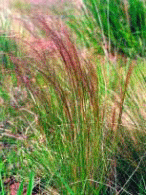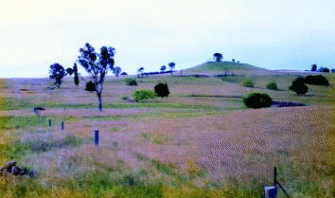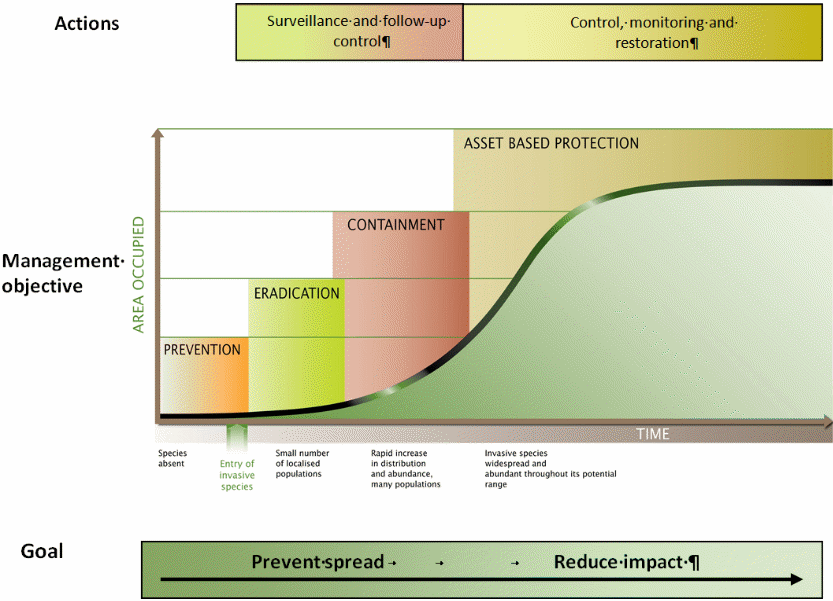Weeds of National Significance (WoNS) are the plants that have adverse environmental, social and economic impacts (Faithful 2012). Due to their adverse effects, the WoNs require strategic plans and programmes to manage. The weeds differ in their effects, the biological, and ecosystem orientation. Therefore, the management strategy of teach weed is unique. In Australia, there are different types of weeds that are categorised as WoNS (Butler & Sindel 2012). Chilean needle grass with the botanical name Nassela neesiana is one of the WoNS. The grass is very invasive and has negative effects on the environment. The Nassela neesiana is a grass indigenous to Chile, Brazil and Argentina (Australia Weed Committee 2012). The weed is easily to identify during flowering. The heads of the grass are have purple colour. Figure 1 is a photograph of a flowering Chilean needle grass (Hocking 2011).

In Australia the weed is categorised as problematic to agriculture and environment, hence; the classification as a WoNS. Outbreaks of the Chilean needle grass have occurred in South Australia, Queensland and Tasmania. Table 1 shows the spread of the Chilean needle grass in various Australian states and the respective measures taken to manage the disease (Butler & Sindel 2012). In different regions of Australia, there are concerted efforts to control WoNS. In the Yarra Ranges, the authorities have classified the various weeds and the probable management strategies.
Table 1: Spread and management of the Chilean disease in Australia. Source: Butler & Sindel 2012.
At the national level, cultural methods and chemical processes have been applied. However, the methods have not yielded good results. As a result, investigations have been carried that have resulted in national strategic plans aimed at containing the Chilean needle grass (Fox & Buckley 2009). The following is a review of the Barkworth Strategic Plan 2012-17 that outlines the national strategies to control Nassela neesiana. The analysis is carried in respect to Yarra Ranges. The core of the review is to evaluate the efficacy of the strategic plan to and to establish whether it is applicable at Yarra Ranges. The review is based on the understanding that a strategic plan that is successful at the local level has a high probability of being successful at the national level.
Brief of the Strategic Plan
Prior to the Barkworth Strategic Plan 2012-17, there was a national strategic plan drawn in 2001 to manage the Chilean needle grass. The plan resulted in a positive progress in the identification and management of the Chilean needle grass. The review of the progress of the 2001 strategic plan proposed the continuation of the strategic plan; hence, the current Barkworth Strategic Plan 2012-17 was devised. The strategic plan is based on three major provisions. The first is the identification of assets that are at risk and devising means to protect them. The second is continuous assessment of the spread of the grass and putting in place measures to restore the infested lands. The third is use of integrated approach to control the spread of the Chilean weed and other stipoid grass weeds. The national plan provides Chilean needle grass’ managers with the tool to foster partnerships across the various jurisdictions. The national strategic goals include the prevention of new Chilean needle grass infestation, management of the infestations that are already existing, and the development of capability and the desire to manage the weed (Australian Weeds Committee 2012). The plan leverages on studying the biology, ecology and effective methods to curb the spread of the weed. Table 2 represents the goals and objectives contained in the Barkworth Strategic Plan 2012-17 (Australian Weeds Committee 2012).
Table 2: Summary of strategic plan goals and objectives. Source: Australian Weeds Committee 2012.
Evaluation of the Strategic Plan
The challenging nature of the management of the Chilean needle grass calls for a strategic plan that addresses the core issues that relate to the grass. The national strategic plan 2012-17 is based on three primary goals. Strategic actions that are required and the authorities responsible for the control processes back the first provision, which entail deterrence of new appearances. For instance, the objective to review and put in place the right state and national legislation that helps in the periodic review of the Chilean needle grass (Australia Weeds Committee). The implementation of the objective is to be carried out at different levels such as state territory, local governments, territory agencies and state.
The strategic plan is based on reducing the infestation of the weed based on expert control. The infestation of the weed can reduce the farm productivity by 50% (Hocking 2011). Figure 2 illustrates heavy Chilean grass invasion (Hocking 2011 ) According to Snell, Grech and Davies (2007) the control of the Chilean grass requires an integrated plan that addresses the various challenges associated with the management of the grass. It is difficult to control the weed due to its complex nature of reproduction. The grass has the ability to asexually reproduce from cleistogene seeds. Measures to deter the flowering do not hinder its spread; hence, integration of various control measures is required. The identification of the weed by non-specialists is not easy. The Chilean grass resembles other non-WoNS during the vegetative stages.

The second strategic goal of the plan is to ensure that the already existing manifestations are put under strategic management (Australian Weeds Committee 2012). According to Hocking (2011), the application of the cultural and the chemical methods has not resulted in tangible success. Studies carried on the control of the Chilean needle grass acknowledge combination of different approaches to curb the spread. According to Faithful (2012), the principle of the combined approach, entail the early intervention, eradication of new and outlying infestation and the use of right management tactics. Due to the invasive and resistance nature of Chilean needle weed, success depends on follow-up over years. The weed has a significant implication on the yield when it attacks paddocks. The reslting effect is an adverse consequence to the agriculture and environment.
The management of the Chilean needle grass requires rich knowledge and expertise to identify the grass and devise mechanism to control the spread (Mclaren, Coventry & Thorp 2002). Figure 3 is an illustration of effective management of Chilean needle grass (Australia Weeds Committee 2012).The principle that underpins the strategic plan is based the fact that the management of the weed is a responsibility for many parties and requires combined approaches.

The current plan is an extension of an earlier strategic plan that had recorded remarkable progress in the management of the Chilean needle grass. The review of the three core goals of management presents a comprehensive action-based plan for prevention, eradication, containment and protection of assets that are under risk. To achieve the objectives of prevention, eradication and containment, the plan leverages on surveillance and follow up while the protection of the asset depends on the control, monitoring and restoration (Australian Weeds Committee 2012).
According to Faithful (2012) the grass is very similar to other native grasses. For example, it resembles the native spear grass hence untrained people cannot identify it. In light of the difficult in the identification of the grass during the early stages, the strategic plan underpins the need for early detection mechanism in the areas that have not been invaded. The priorities of the plan are put on strategic actions to achieve the desired outcomes based on the goals and the objectives. Even though the goal to prevent the new infestations outlines measurable plans to prevent the spread, it fails to put into consideration the mechanism that the locals can use to identify new outbreaks.
The management of the existing infestations is a priority for the strategic plan. The plan outlines that the management is to be based on various levels in which the biological control is pointed as one of the important tools to manage and restore the main infestations (Australian Weeds Committee 2012). A research conducted by Hocking (2011) indicated that the chemical and cultural methods have not achieved better results. Therefore, the application of biological controls presents a good alternative for the management. The studies carried on the use of biological control found the Chilean needle grass to be resistant against Eromyce pencanus. However, further studies have shown that two isolates infect the Chilean needle grass (Hocking 2011).
The goal is also based on a holistic approach that also calls for the reestablishment of competitive native grasslands. The use of the biological controls is still under investigation. If the biological agents under investigations are found to be viable, the approved agents will be spread throughout Australia to curb the spread of the Chilean needle grass. In addition, the plan aims at identification and prioritisation of assets at different levels in order to reduce its adverse effects. According to Faithful (2012), the Chilean needle grass is very persistent. A square metre of infestation can produce over twelve thousand seeds; hence, the grass has a high potential to outdo the native grasslands. The grass has great socio-economic implication. The sharp needles like seeds easily pierce grazing animals. Specifically, the areas infested by the weed make it difficult for the sheep to graze as it contaminates the fleece of sheep thus making it difficult to shear the sheep. The problem has seen some farmers stop sheep grazing due to its effect.
Butler and Sindel (2012) noted that in the advent of high-level infestation of a paddock with the Chilean needle grass, the management becomes difficult. The weed is very aggressive. Therefore, the grass should be removed immediately it is discovered. Fox and Buckley (2009) noted that the minimisation of the infestation is achievable by creating conditions that prevent its growth and reproduction. In the light of the view, the second goal of the strategic plan provides a comprehensive outline and measurable objectives to minimise the effects of the Chilean grass. Critical to the management is the identification and mapping of risk assets and investing in research that relate to identification and control of the grass.
In Argentina, there are research trials to investigate the ability of rust fungus Puccina nassellae. The studies are aimed at ensuring that the use of the agent as a biological control does not attack other non-WoNS. In line with the researches, in Australia, the strategy aims at investigating biological agents that can be applied to control the Chilean needle grass. The successful agents will be spread to the entire nation. Therefore, the land managers including those in Yarra Ranges will be able to adopt the biological control (Australia Weeds Committee 2012).
The third goal underscores the need for the land managers to have the right skills to identify the infestations of the grass and control it. Thus, it denotes the need for all stakeholders to have the prevention and management willingness if success is to be achieved. There are biological controls programs that are at advanced trial stages. Based on the different goals and subsequent objectives, the plan provides a comprehensive strategy that can be applied at the national level. However, the strategy is structured in a manner to favour the trained land managers and specialists. For the plan to be applicable at the local level, it should precisely incorporate strategies that the locals can use to identify the grass.
Improvements of the Strategy
A plan that cannot succeed at the local level cannot achieve its goal at the national level. Based on the perspective, the implementation of the strategic plan in Yarra Ranges presents an opportunity to investigate its applicability. In Yarra, the authorities have identified various weeds that are considered problematic in the Yarra Ranges and the urban city of Yarra. In Yarra ranges, the approved management for the problematic weeds such as Chilean needle grass entails integrated control. The integrated control puts in place different strategies to curb the spread of the weeds such as legislation, use of herbicides, mechanical removal, replacement and adoption of bio-control agents.
The application of the strategy in the Yarra Ranges may be limited because the locals do not have the knowledge to identify the grass in the early stages. Furthermore, the national strategy is based on technical and expert control; thus, it does not provide the mechanisms to involve the locals in the awareness and the detection of the grass. Bearing in mind the resemblance with the various native species, the strategy is limited to the specialists. Therefore, for the strategy to be successful there is the need for revision of the strategies to include creation of awareness for all people. For example, in order to be successful at Yarra Ranges, the plan should integrate clear identification processes that can be used by locals.
References
Australian Weeds Committee. 2012. Chilean needle (Nassela neesiana) (Trin. & Rupr.) Barkworth strategic plan 2012-2017. Weeds of National Significance, Government Department of Agriculture, Fisheries and Forestry, Canberra.
Butler, K. and Sindel, B. 2012. Assessment of management options for Chilean needle grass in sheep-grazing systems. Grass &Forage Science, vol. 69, no.1.pp.119-128.
Faithful, I. 2012. Biodiversity impacts of Chilean needle grass in Australian temperate native grasslands, Victoria University, Melbourne.
Fox, J. and Buckley, Y. 2009. Surveillance for management of invasive plants: modeling Chilean needle grass (Nassella neesiana) in Australia. Diversity and Distributions, vol. 15, no. 4. pp. 577-589.
Hocking, C. 2011. Guidelines for minimising waterway infestations of needle grass: field notes, report for the Australian Government Department of Agriculture, Fisheries and Forestry, Canberra.
McLaren, D., Coventry, R. & Thorp, J. 2002. Stipoid grasses as Weeds of National Significance. Plant Protection Quarterly, vol.17, no.3, pp.119–124.
Snell, K. Grech, C. and Davies, J. 2007. Chilean needle grass national best practice management manual, Department of Primary Industries, Melbourne.